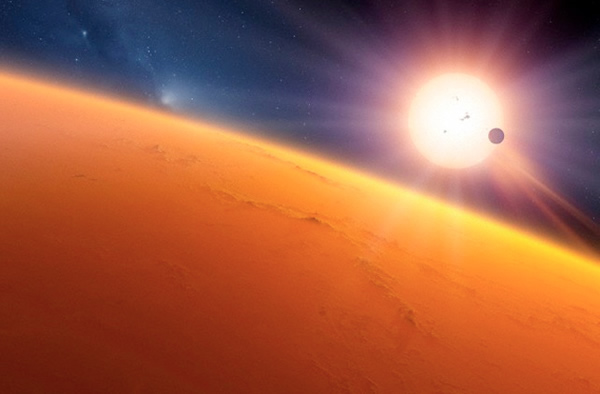Trickster Exoplanets May 'Fake' Life Signatures
An exoplanet orbiting a red dwarf star may appear to have signatures for life, when in fact those signatures are being generated by non-biological processes.
In the quest for life beyond Earth, a planet with oxygen in its atmosphere is considered the Holy Grail. But appearances can be deceiving.
So says a team of scientists studying a particular type of star known as an M dwarf, or red dwarf. These long-lived stars, which are smaller than the sun, account for about 75 percent of the stars in our galaxy.
Astronomers found that M dwarf stars have relatively high levels of far-ultraviolet radiation -- 1,000 times more than the sun. These emissions could trigger chemical reactions in an orbiting planet's atmosphere that create oxygen and ozone.
"This could be taken as a false positive (for life)," said astronomer Feng Tian, with the Center for Earth System Science at Tsinghua University in Beijing, China.
"If you observe these planets’ atmospheres, you’ll see oxygen and you may think ‘Oh the oxygen could come from life, like plants on our own planet,’ but actually that is not the case," Tian told reporters during a webcast press conference at the American Astronomical Society meeting in Denver this week.
The discovery has implications for a new generation of planet-hunting observatories, such as NASA’s planned Transiting Exoplanet Survey Satellite, or TESS, a follow-on to the now-defunct Kepler space telescope.
Like Kepler, TESS will look for minute changes in the amount of light coming from target stars, which could be caused by planets passing by relative to the telescope’s line of sight. For small host stars, like M dwarfs, a transiting planet would block proportionally more of its light, making the detection easier.
"M dwarfs have been considered the fast track for the search of extraterrestrial life," Tian said.
"In order to understand whether there is life on these planets, we need to look at the photochemistry," he added
Tian and colleagues used Hubble Space Telescope data to look at the ultraviolet emissions from four M dwarf stars, including one that has three planets located in its so-called “habitable zone” where temperatures are suitable for liquid surface water.
In related research, another team of astronomers pointed out that carbon-rich systems may be deplete of water-bearing bodies, dimming prospects for life.
"Planets in the habitable zones of these systems might have lots of other interesting things. They might have carbon. They might have organics. But they might lack a key ingredient -- water,” said Torrence Johnson, a senior research scientist at NASA’s Jet Propulsion Laboratory in Pasadena, Calif.(Oct 9, 2013 07:00 AM ET // by Irene Klotz)












